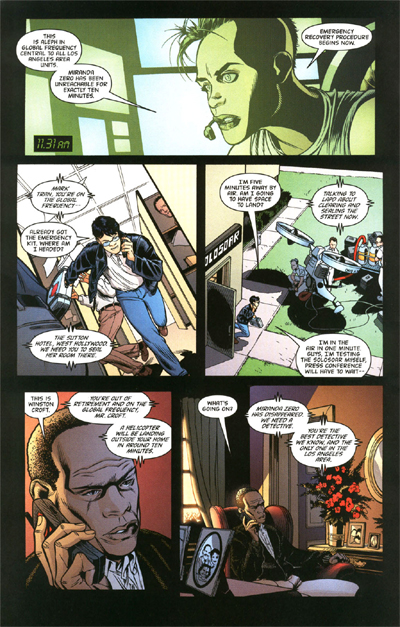
On Sundays, Felan profiles his favourite comics and graphic novels from across the diverse medium’s history.
More Warren Ellis this week! Global Frequency is a mini-series comprised of 12 one-shot stories, each penned by Ellis and illustrated by a different artist, including some big names like Gene Ha, and what I consider to be the single greatest penciller and inker pairing in the business, Chris Sprouse and Karl Story (issue #8). All the stories, while self-contained, are linked by the eponymous shadowy covert organization that always seems ready to save the world…
The Global Frequency is basically a real-life Wiki-like organization of 1,001 people around the world, coordinated by a central hub to deal with disasters, crises and other dangerous situations. Each individual agent is an otherwise ordinary person who specializes in a particular field (computers, chemical engineering, parkour, hand-to-hand combat, etc.), and has no knowledge of the larger organization beyond having been recruited and given a high-tech communication device that summons them when needed. The best thing about Global Frequency is that it’s essentially a superhero comic, but instead of one, all powerful hero, the “hero” of the story is a crowd-sourced, distributed network of specialist but otherwise unremarkable individuals.Each issue depicts a new crisis, and a purpose-specific team is assembled from the 1,001 agents and dispatched. In some cases, the missions are executed entirely via phone and the Internet, while others require the team to meet in a specific location to confront the threat. The threats range from psychopathic mutants, to doomsday cults, to hive-mind meme viruses, all characteristic fixations of Ellis’ work. Most of the series is action-driven, but Ellis also weaves horror, science-fiction and other generic elements into various stories.

The only recurring characters in the series are Miranda Zero, the mysterious director of Global Frequency, and Aleph, a hacker who controls the central communications hub and coordinates the organization’s activities. Given the nature of the organization, there is minimal characterization, but the series is full of little glimpses into the everyday lives of the agents, which give a sense of realism and also provide a source of humour – in the first issue, an MIT expert on black holes provides valuable information to the team while in full BDSM gear (only the audience is aware of this, making it even more delightful).
Because it’s a mini-series, Global Frequency leaves you wanting more, and doesn’t offer any conclusions or revelations about the nature of the organization, but part of its charm is that it alludes to so much without ever directly explaining anything, just as the agents on the Frequency themselves never really learn any more than is absolutely necessary for them to complete the mission.
Global Frequency was originally published by the sadly now-defunct Wildstorm Comics, and is now available in two trade paperbacks, Planet Ablaze and Detonation Radio, from DC Comics. More info here: http://www.dccomics.com/dccomics/graphic_novels/?gn=1753
BONUS: A Global Frequency television pilot was produced but never aired, and can be viewed or downloaded easily via the Internet. It’s not very good, and very much misses the point of not having the agents as recurring characters, but is interesting nonetheless. (Rumor has it a new series is in production as well.)
